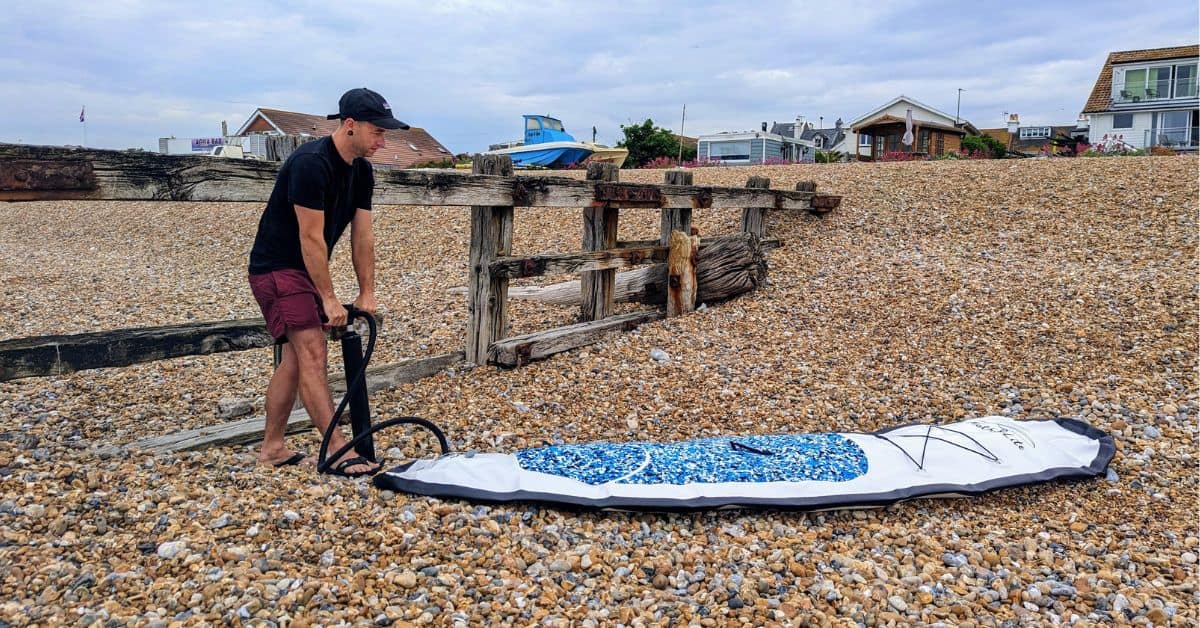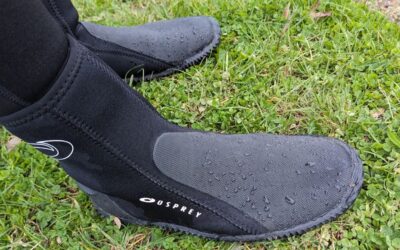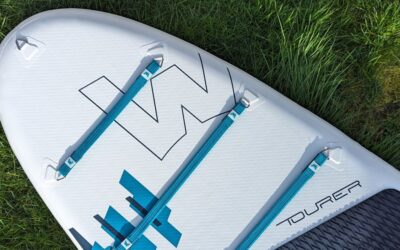Stand up paddle boarding (SUP) is an increasingly popular water activity, loved for its blend of physical workout and tranquillity.
For those learning how to SUP, one essential skill to master is how to inflate your paddle board correctly and deflate after use. It might sound straightforward, but doing it right is crucial not only for the board’s performance but also for its lifespan.
In this article, I will walk you through everything you need to know about inflating and deflating your SUP board correctly.
Let’s dive right in!
Understanding Your Paddle Board
As an enthusiast of stand-up paddleboarding, the first thing you should acquaint yourself with is your paddle board. Every paddle board is unique, complete with its own optimal inflation pressure, typically measured in PSI (pounds per square inch). Understanding this figure is the foundation of successful paddle boarding.
Disclaimer: If you make a purchase via the links on our site, I may earn an affiliate commission at no additional cost to you. You can read my affiliate disclosure in the privacy policy. Thanks for your support!
The Benefits of Proper Inflation and Deflation
The correct inflation and deflation of your paddle board is not an arbitrary procedure. When your paddle board is inflated to the correct PSI, it ensures optimal performance, stability, and safety. Overinflation could result in rigidity and potential damage to the board, whereas underinflation can compromise its balance and speed.
Deflating your paddle board properly and storing it correctly extends its longevity and maintains its performance. Proper care of your paddle board is a rewarding investment in the long run.
How to Inflate Your Paddle Board
Preparing Your Board for Inflation – Start by unrolling your paddle board on a flat, clean surface free of sharp objects.
Find the valve – usually located towards the tail of the board – and remove the cap. Ensure the valve is in the closed position before attaching the pump hose.

A Step-by-step Guide to Inflation
Inflating your paddle board might seem laborious initially, but with the right steps, it’s a breeze. Here’s a step-by-step guide:
- Connect the pump hose to the valve.
- Begin pumping. If your pump offers a double-action mode (pumps air both on the up and down strokes), start with this setting.
- As the board begins to take shape, you might need to switch to single-action mode (pumps air only on the down stroke) if your pump allows.
- Keep an eye on the pressure gauge and stop when you reach the recommended PSI.
Although the process of inflating your paddle board can be physically demanding, a few tips and tricks can make it a cinch. Ensure the pump hose is securely attached to prevent air leakage. If you have an electric pump, inflation can be much faster and far less strenuous.
Reading the Pressure Gauge
Accurate reading of your pressure gauge is key to ensuring your paddle board is inflated correctly. When the needle on the gauge hits the recommended PSI for your board, cease pumping immediately.

Adjusting the Inflation Level
Your paddle board should feel firm, with only a tiny bit of give when you press into it. If it feels too soft, continue pumping to add more air. If it feels overly hard, gently press the valve to release a bit of air.
How to Deflate Your Paddle Board
Begin the deflation process by first ensuring the board is as clean and dry as possible then open the valve, typically done by pressing and turning it.
A Step-by-step Guide to Deflation
Deflating your paddle board is a simple process that takes only a few minutes:
- Once the valve is open, air should begin to escape.
- Once deflated, gently roll up the board, starting from the nose and finishing at the tail, to squeeze out any remaining air.
- Secure the rolled board with a strap or in a bag for storage.
- Safely Storing Your Deflated Paddle Board
- Never underestimate the importance of correct storage. A cool, dry place away from direct sunlight is ideal. Incorrect storage can cause material breakdown, leading to damage and shortening the lifespan of your board.

Using an Electric Pump for Inflating Your Paddle Board
While manual pumps are more common, electric pumps are increasingly making their way into the market, offering a convenient alternative for inflating paddle boards.
A Step-by-step Guide to Using an Electric Pump
Using an electric SUP pump makes inflation a breeze, allowing you to tackle other tasks before you hit the water. Follow these simple steps to inflate your board:
- Set up the Pump: First, you’ll need to connect the electric pump to a power source. Some electric pumps are battery-operated, while others require a connection to a car’s 12V DC outlet. After that, connect the pump’s hose to the paddle board’s valve.
- Set the PSI: Electric pumps come with an adjustable setting allowing you to select the desired PSI. Make sure you adjust this according to your paddle board’s recommended inflation level.
- Inflation: With the PSI set, turn on the pump. The pump will automatically inflate the board to the set PSI and stop.
- Disconnect: Once the pump has automatically turned off, disconnect the hose from the valve and place the cap back on the valve.
Benefits of Using an Electric Pump
The primary benefit of using an electric pump is convenience. Here are some specific advantages:
Effortless Inflation: Electric pumps take the manual labor out of the inflation process. Just set the desired PSI and let the pump do the work. This feature is particularly beneficial for individuals who may find the manual pumping process physically challenging.
Time-saving: Electric pumps are usually faster than manual pumps, allowing you to get out on the water quicker. This feature is especially handy when you’re eager to start your paddling adventure.
Accurate Inflation: With the automatic shut-off feature, you can rest assured that your board will be inflated to just the right pressure, reducing the risk of underinflation or overinflation.
Multi-functional: Some electric pumps also offer deflation settings, making it even more versatile and useful.
While an electric pump might be more of an investment compared to a manual pump, the convenience and accuracy it provides can be worth the cost for regular paddle boarders or those who prioritize ease and speed.
Common Mistakes to Avoid When Inflating and Deflating Your Paddle Board
Understanding the do’s and don’ts of inflating and deflating your paddle board is integral to the longevity and performance of your board. Let’s take a closer look at some common paddle boarding mistakes to avoid.
Ignoring the Manufacturer’s PSI Recommendation: This is the cardinal rule of paddle board inflation – always abide by the recommended PSI (Pounds per Square Inch) provided by the manufacturer. Ignoring this guidance can have serious consequences. The PSI value is not arbitrary; it has been calculated to ensure optimal performance and safety for that specific board.
Overinflation: Overinflation is a common mistake, especially among beginners. An overinflated paddle board becomes overly rigid and more susceptible to damage, particularly under high temperatures. It could also cause the board to burst, risking injury.
Underinflation: Underinflated paddle boards are just as problematic. They are sluggish in the water, difficult to balance on, and the sagging can damage the board’s material over time. Also, they may not support your weight effectively, which can lead to safety issues.
Incorrect Valve Positioning: Not checking if the valve is in the correct position before inflating can lead to air leakage. Always ensure the valve is in the closed position before starting to inflate.
Rapid Deflation: When deflating, it’s essential not to force the air out too rapidly as it could damage the valve and the board’s material. Allow the air to escape naturally or use a pump with a deflation function for a more controlled process.
Poor Storage After Deflation: After deflation, the paddle board should be cleaned, dried, and stored correctly. Incorrect storage, like leaving it exposed to sunlight or not drying it thoroughly before storing, can lead to material degradation and decrease the board’s lifespan.
Using the Wrong Pump: Utilize a pump suitable for inflating SUPs. Using a different pump (like one for car tires) can result in overinflation or damage to the valve.
By being aware of these common mistakes, you can effectively avoid them and ensure your stand-up paddleboarding experiences are always safe, fun, and efficient. Remember, proper care and maintenance start from the moment you inflate your paddle board to when you pack it away after a great day on the water.
Final Thoughts
Properly inflating and deflating your stand up paddle board is a vital part of your SUP experience that greatly affects both your safety and your board’s performance. Regardless of whether you’re using a manual or an electric pump, it’s essential to adhere to your board’s recommended PSI to prevent harmful overinflation or underinflation.
By being vigilant during the inflation and deflation process and steering clear of common mistakes, you can keep your SUP board in excellent condition, ready for countless more adventures. So, get your paddle board prepared with care, and look forward to an exciting and safe SUP journey on the water.
FAQ
How long does it take to inflate a paddle board?
It usually takes between 5 to 10 minutes depending on the pump used and the individual’s strength.
What happens if I overinflate my paddle board?
Overinflation can damage the board’s structure and potentially cause it to burst, especially in hot weather.
Can I leave my paddle board inflated?
Yes, but only if you are using it regularly. Long-term storage should be deflated to avoid damage.
How often should I replace my paddle board’s pump?
A good-quality pump can last several years if properly maintained. Replace it if you notice issues like low efficiency or physical damage.
Can I use an electric pump to inflate my paddle board?
Yes, electric pumps are efficient and save a lot of manual effort, making them a good investment for regular paddlers.

About the Author
Steve Cleverdon is an adventure blogger dedicated to helping outdoor enthusiasts make the most of their outdoor experiences. With years of travel and many epic adventures including a 3000-kilometre solo hike across New Zealand, Steve has amassed practical knowledge on outdoor gear. You can learn more about his adventures here. Through expert reviews, recommendations, and guides, he equips his readers with the best gear for their next adventure. If you want to send Steve a quick message, visit his contact page here.




